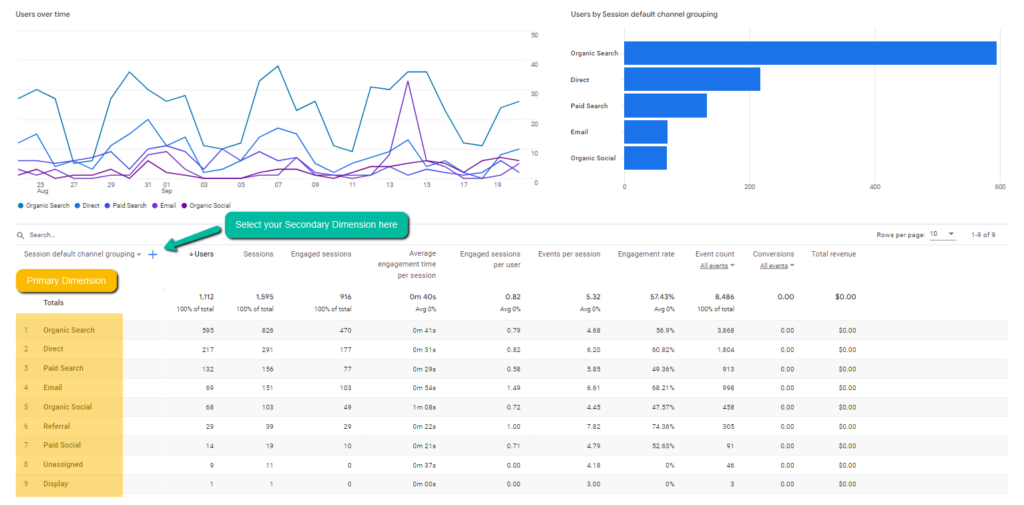Secondary Dimension in Google Analytics: Unlocking Advanced Metrics
Make Best Use Of Coverage Accuracy With Additional Measurement in Google Analytics
Understanding exactly how to maximize reporting accuracy with additional dimensions in Google Analytics can substantially boost the deepness of understandings acquired from information evaluation. By including secondary dimensions strategically, online marketers can discover concealed patterns and relationships that may not be promptly obvious when evaluating key metrics alone.
Comprehending Additional Dimensions in Google Analytics
Second measurements enable users to sector and additionally dissect data past the primary measurement selected. While the main measurement may show the complete number of page views, including a second dimension such as 'source/medium' can supply understandings into where the web traffic stemmed from.
Additionally, understanding additional dimensions is crucial for developing extra customized reports tailored to particular organization goals. By picking the ideal mix of secondary and key dimensions, experts can reveal patterns, patterns, and relationships that could or else remain covert. This nuanced strategy to data evaluation encourages services to make educated decisions based on a thorough understanding of customer habits throughout different dimensions.

Just How to Apply Secondary Dimensions
When leveraging secondary measurements in Google Analytics, the functional application entails choosing certain information specifications to additional improve insights past the main measurement's range. To use secondary dimensions effectively, begin by accessing the record or dataset where you desire to delve much deeper right into the information. Within Google Analytics, find the primary measurement that you are presently analyzing. Once determined, click on the dropdown menu identified "Additional Dimension." This activity will reveal a listing of additional parameters that can be included in your evaluation. Select the secondary measurement that aligns with your logical goals, such as 'Source/Medium,' 'Tool Category,' or 'Location.' By selecting a secondary dimension, you can gain much more comprehensive insights into user behavior, demographics, or procurement networks. Keep in mind that secondary measurements aid give context and granularity to your key measurement data, enabling you to draw out even more actionable and purposeful insights from your Google Analytics reports.
Leveraging Second Measurements for Insights
Using secondary measurements in Google Analytics enables for an extra comprehensive analysis of data, using important understandings past the key measurement's scope. By leveraging additional dimensions, users can dig deeper right into the efficiency metrics of their web site or application, uncovering covert patterns and trends that may not be promptly noticeable when only checking out main dimensions.
One key advantage of making use of additional measurements is the capability to section and filter data much more precisely. This can assist analysts and marketers better recognize the actions of specific customer sectors, such as new visitors versus returning site get redirected here visitors, or website traffic coming from different geographical locations.
Furthermore, additional measurements make it possible for users to contrast and contrast various information points within the same record, providing an extra all natural view of efficiency (Secondary Dimension in navigate to this website Google Analytics). As an example, coupling the primary dimension of landing pages with secondary measurements like demographics or tools can disclose which pages are most efficient in involving individuals on different gadgets or from different demographic groups.
Essentially, leveraging secondary measurements in Google Analytics empowers users to remove richer understandings from their information, leading to more informed decision-making and eventually, boosted performance.
Ideal Practices for Additional Dimensions
When examining data in Google Analytics, including additional dimensions properly enhances the depth of insights obtained from the primary metrics. Choosing pertinent secondary measurements aids in supplying context and a clearer understanding of the information being taken a look at.
Moreover, it is suggested to limit the variety of secondary measurements utilized in a single report to stay clear of frustrating the evaluation with also much details. Focusing on a couple of key secondary dimensions at once can cause even more focused and workable understandings. Furthermore, take into consideration try out various combinations of key and secondary dimensions to discover unique trends and patterns that may not be evident when taking a look at the data alone.
Advanced Evaluation Techniques With Additional Dimensions
Discovering elaborate information relationships via the strategic application of additional measurements can unveil nuanced understandings that elevate the depth of analysis in Google Analytics. By integrating second dimensions with main information sets, sophisticated evaluation techniques can be utilized to draw out beneficial details. One such strategy is accomplice analysis, where additional dimensions permit the segmentation of customers right into teams sharing common features. This method makes it possible for a deeper understanding of individual habits patterns gradually, aiding in the recognition of fads and the evaluation of marketing campaigns' efficiency.
In addition, secondary dimensions can boost the analysis of conversion paths by offering extra context. Comprehending the different touchpoints an individual connects with additional hints prior to converting can be vital in maximizing the customer journey - Secondary Dimension in Google Analytics. By making use of second dimensions to look into specifics such as traffic sources or tools utilized, marketing professionals can tailor approaches to target high-converting networks efficiently
Verdict

To boost data evaluation and gain deeper understandings right into user behavior, understanding second measurements in Google Analytics is imperative - Secondary Dimension in Google Analytics. Secondary measurements allow users to section and further dissect data past the main measurement chosen. While the main dimension might present the complete number of page sights, adding a second dimension such as 'source/medium' can supply insights into where the web traffic originated from.When leveraging additional dimensions in Google Analytics, the sensible application includes choosing certain information criteria to further fine-tune understandings beyond the key dimension's extent. Remember that secondary dimensions aid supply context and granularity to your main dimension data, allowing you to draw out even more actionable and significant understandings from your Google Analytics records